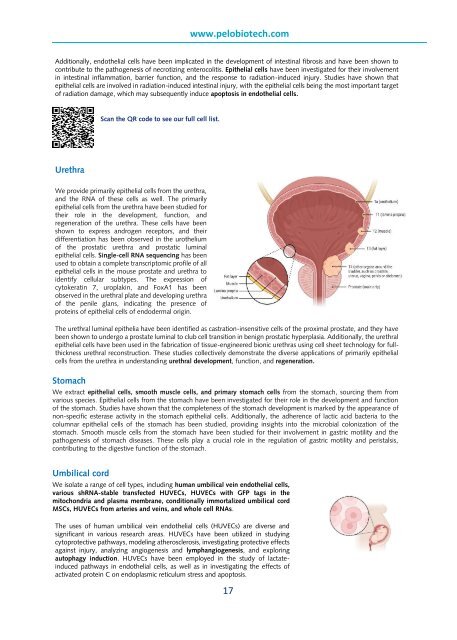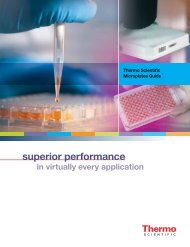PeloBiotech
Create successful ePaper yourself
Turn your PDF publications into a flip-book with our unique Google optimized e-Paper software.
www.pelobiotech.com<br />
Additionally, endothelial cells have been implicated in the development of intestinal fibrosis and have been shown to<br />
contribute to the pathogenesis of necrotizing enterocolitis. Epithelial cells have been investigated for their involvement<br />
in intestinal inflammation, barrier function, and the response to radiation-induced injury. Studies have shown that<br />
epithelial cells are involved in radiation-induced intestinal injury, with the epithelial cells being the most important target<br />
of radiation damage, which may subsequently induce apoptosis in endothelial cells.<br />
Scan the QR code to see our full cell list.<br />
Urethra<br />
We provide primarily epithelial cells from the urethra,<br />
and the RNA of these cells as well. The primarily<br />
epithelial cells from the urethra have been studied for<br />
their role in the development, function, and<br />
regeneration of the urethra. These cells have been<br />
shown to express androgen receptors, and their<br />
differentiation has been observed in the urothelium<br />
of the prostatic urethra and prostatic luminal<br />
epithelial cells. Single-cell RNA sequencing has been<br />
used to obtain a complete transcriptomic profile of all<br />
epithelial cells in the mouse prostate and urethra to<br />
identify cellular subtypes. The expression of<br />
cytokeratin 7, uroplakin, and FoxA1 has been<br />
observed in the urethral plate and developing urethra<br />
of the penile glans, indicating the presence of<br />
proteins of epithelial cells of endodermal origin.<br />
The urethral luminal epithelia have been identified as castration-insensitive cells of the proximal prostate, and they have<br />
been shown to undergo a prostate luminal to club cell transition in benign prostatic hyperplasia. Additionally, the urethral<br />
epithelial cells have been used in the fabrication of tissue-engineered bionic urethras using cell sheet technology for fullthickness<br />
urethral reconstruction. These studies collectively demonstrate the diverse applications of primarily epithelial<br />
cells from the urethra in understanding urethral development, function, and regeneration.<br />
Stomach<br />
We extract epithelial cells, smooth muscle cells, and primary stomach cells from the stomach, sourcing them from<br />
various species. Epithelial cells from the stomach have been investigated for their role in the development and function<br />
of the stomach. Studies have shown that the completeness of the stomach development is marked by the appearance of<br />
non-specific esterase activity in the stomach epithelial cells. Additionally, the adherence of lactic acid bacteria to the<br />
columnar epithelial cells of the stomach has been studied, providing insights into the microbial colonization of the<br />
stomach. Smooth muscle cells from the stomach have been studied for their involvement in gastric motility and the<br />
pathogenesis of stomach diseases. These cells play a crucial role in the regulation of gastric motility and peristalsis,<br />
contributing to the digestive function of the stomach.<br />
Umbilical cord<br />
We isolate a range of cell types, including human umbilical vein endothelial cells,<br />
various shRNA-stable transfected HUVECs, HUVECs with GFP tags in the<br />
mitochondria and plasma membrane, conditionally immortalized umbilical cord<br />
MSCs, HUVECs from arteries and veins, and whole cell RNAs.<br />
The uses of human umbilical vein endothelial cells (HUVECs) are diverse and<br />
significant in various research areas. HUVECs have been utilized in studying<br />
cytoprotective pathways, modeling atherosclerosis, investigating protective effects<br />
against injury, analyzing angiogenesis and lymphangiogenesis, and exploring<br />
autophagy induction. HUVECs have been employed in the study of lactateinduced<br />
pathways in endothelial cells, as well as in investigating the effects of<br />
activated protein C on endoplasmic reticulum stress and apoptosis.<br />
17
















